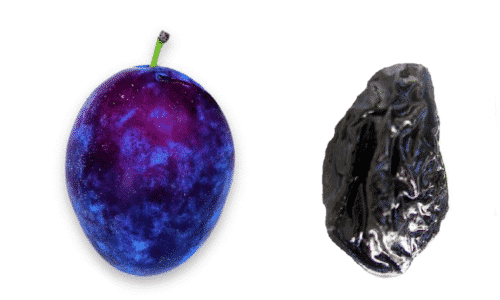1 – What is “un Far Breton”?
Je dirais que le far est le dessert le plus courant, le plus apprécié en Bretagne (région du nord-ouest de la France). Il y a toujours un morceau de far dans une cuisine bretonne. Et en plus, c’est une recette très facile à faire.
I would say that “le far” is the most common and most popular dessert in Brittany (North-west region of France). There is nearly always a piece of “far” in a Breton kitchen! Plus, it is very easy to make this recipe!
Le nom même de ce gâteau pourrait avoir l’air très redondant. Le seul mot « far » devrait suffire, puisque tout le monde sait que le far est un gâteau breton (les gens pensent d’habitude que c’est un mot breton alors qu’en fait, il provient du mot « farine » en latin) et puisque tous les fars sont faits avec des pruneaux.
The very name of this cake or pudding might sound very redundant. The single word “Far” would be enough, since everybody knows that “far” is a Breton cake (people usually think the word is Breton though it comes from the word “flour” in Latin), and since all “far” are in principle baked with prunes.
2 – Prune et Pruneau – Avoid a French Mistake!
Au fait, attention aux faux amis : «une prune » veut dire « a plum », et «un pruneau » veut dire «a prune » !
By the way, watch the faux amis : “une prune” is “a plum” and “un pruneau” is “a prune”.

Certaines personnes considèrent le far comme un flan ou un clafoutis, mais ceci est une erreur grossière. Si vous désirez avoir des amis bretons, évitez ce genre de gaffe !
Many people consider le far as a flan or a clafoutis, but this is a great mistake. If you want to have Breton friends, just avoid such a blunder…
3 – Typical Far Breton Ingredients :
- – 250 grammes de farine
- – 150 grammes de sucre
- – 5 gros œufs
- – Environ 80 centilitres de lait
- – Environ 150 grammes de pruneaux dénoyautés
- – Quelques gouttes d’eau de fleur d’oranger
Translation:
- – 250 grams of flour
- – 150 grams of sugar
- – 5 large eggs
- – About 80 centiliters of milk
- – Around 150 grams of pitted prunes
- – A few drops of orange flower water

A new approach to learning both traditional and modern French logically structured for English speakers.
4 – Far Breton Recipe – How To Make this Typical Dessert From Brittany
- Pré-chauffer le four à 450 degrés F (230 degrés celsius). Beurrer et fariner un grand plat à gâteau rond, ovale ou carré et mettre dans le fond tous vos pruneaux dénoyautés. Bien mélanger la farine et le sucre.
Preheat the oven to 450 degrees F (230 Celsius). Grease and flour a shallow round, oval or square baking dish and put on the bottom all your pitted prunes. Whisk together the flour and sugar. - Mélanger les œufs un à un, en battant bien après chaque ajout. Verser progressivement le lait, mélanger avec vigueur avec une cuillère jusqu’à ce soit bien mélangé. Ajouter l’eau de fleur d’oranger. Vous remarquerez que cette pâte très liquide est presque identique à celle des crêpes.
Whisk in the eggs one at a time, beating well after each addition. Pour in the milk gradually, stirring vigorously with a spoon until combined. Stir in the orange flower water. You’ll notice that this very thin batter is almost the same as pancake batter. - Faire cuire dans le four pré-chauffé pendant dix minutes, dans la partie supérieure du four. Baisser la température du four à 400 degrés et faire cuire environ 35 minutes. Le far doit avoir monté et le dessus doit avoir foncé.
Bake in the preheated oven (on the upper part) for 10 minutes. Reduce oven temperature to 400 degrees F, and bake around 35 minutes, until the filling is firm. It must have risen and the top must be brown. - Servir à la température de la pièce, en tranches longues et rectangulaires (c’est la façon traditionnelle, voir la photo). Irène, ma chère voisine, fait aussi le far en ramequins, en parts individuelles, et elle ne dénoyaute pas les pruneaux.
Serve at room temperature, in small long rectangular slices ( this is the traditional way, see picture). Irène, my dear neighbor, also bakes her “far” in ramekins, as individual parts, and she does not pit the prunes. - Par ailleurs, en dépit de ce que j’ai écrit au début : pour ceux qui seraient allergiques aux pruneaux (comme la plupart de mes amis australiens), on peut remplacer les pruneaux par des abricots secs ou des raisins secs ou des cerises.
Also, in spite of what I wrote in the beginning of this recipe, for those who have some prune allergy (as most of my Australian friends), one can replace prunes by dried apricots, raisins or cherries.

Connaissez-vous un autre dessert qui est 100% bretons ? Les crêpes bien sûr !!
Do you know another 100% Breton desert? Crêpes of course!
If you liked this article, why not consider a stay at Suzannel’s home in Brittany to better your French? Here is more info about the French Immersion Residential courses recommended by French Today.








Comments